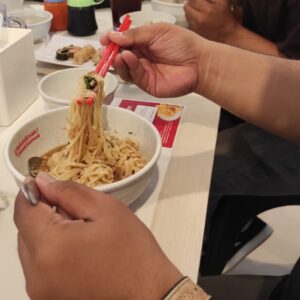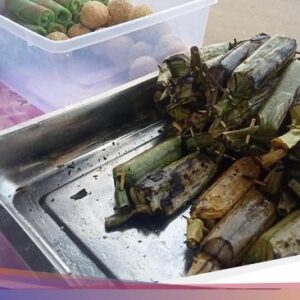Mataram –
Sambal is a mandatory dish when enjoying any Indonesian cuisine. Indonesian people don’t think it’s right to eat without chili sauce. It is not surprising that each region in Indonesia has its own special chili sauce, including West Nusa Tenggara (NTB).
NTB people have a variety of favorite special chili sauces, not only in the Sumbawa region but also outside the region. Although most chili sauces have a spicy taste, there are also those that have a salty or sour taste.
Here are five typical NTB chili sauces that you can try making in a simple way at home.
ADVERTISEMENT
SCROLL TO CONTINUE WITH CONTENT
Doco Doma Sambal
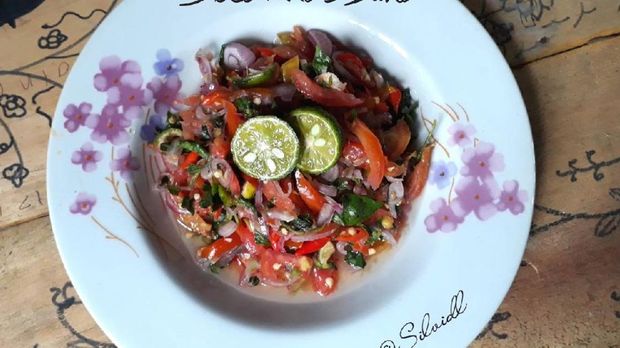 Doco Bima Sambal – Silvia DL – Cookpad Doco Bima Sambal – Silvia DL – Cookpad |
Doco Doma Sambal is a typical NTB chili sauce originating from Bima City. The name ‘Doco’ in the Bima language means tomato, which is the main ingredient in this chili sauce. Tomatoes are mixed with basil, cucumber, shallots and eggplant, which makes this chili sauce more textured and has a unique taste. This chili sauce is perfect served with grilled fish and warm rice.
Ingredients:
• Cucumber to taste
• Enough round eggplant
• Tomato
• A handful of basil
• Red onion
• Cayenne pepper and red chili
• 1/2 tsp ground pepper
• Salt and stock seasoning to taste
• 4 limes
How to make:
1. Cut the tomatoes and cucumber into dice. Cut the shallots into similar sizes.
2. Wash the basil leaves thoroughly. Cut the eggplant into dice
3. Mix basil leaves, cucumber pieces, red onion, tomatoes and eggplant in one place
4. Add salt, ground pepper and lime juice.
5. Coarsely grind the red chilies and cayenne peppers, then mix them into the chili sauce ingredients. Use gloves to squeeze the chili sauce.
6. Add a little lime juice if needed.
7. Sambal is ready to be served with grilled fish and fried chicken.
Padang Sira Sambal
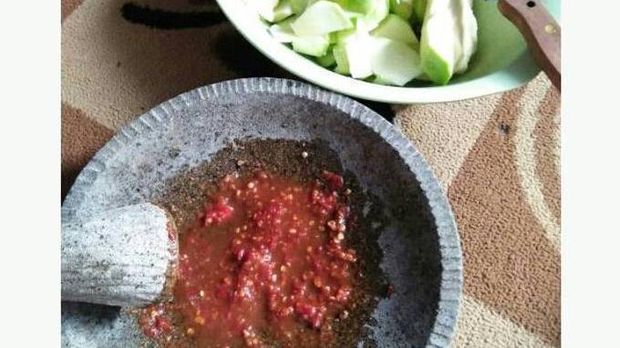 Sambal Sirapadang_Eka Arisanta-Cookpad Sambal Sirapadang_Eka Arisanta-Cookpad |
This typical Sumbawa chili sauce has a spicy, salty taste, as the name suggests ‘Sira Padang’ which means spicy salt. This chili sauce is made with very simple ingredients, namely salt and chili.
Sira Padang Sambal is usually used as a dip for young mangoes and other sour-flavored foods. This chili sauce has a very strong spicy and salty taste. If you are not used to salty food, chili sauce may not be suitable for you.
Ingredients:
• Salt
• Cayenne pepper
How to make:
1. Blend the salt and cayenne pepper
2. The chili sauce is ready to be served with young mango.
Baberuk Sambal
 Sambal Baberuk_Dita Mulya-Cookpad Sambal Baberuk_Dita Mulya-Cookpad |
Baberuk Sambal is a typical Lombok chili sauce made from vegetables such as long beans and eggplant. This chili sauce is served with chili sauce made from chilies, garlic and shallots. Baberuk eggplant is often an accompaniment to chicken taliwang and other typical Lombok dishes.
Ingredients:
• Long beans
• round purple eggplant
• Tomato
• 1 lime
• 1 tablespoon cooking oil
Ground spices:
• 2 cayenne peppers
• 3 curly red chilies
• 4 red onions
• 1 clove of garlic
• 1 tsp grilled shrimp paste
• 1 tsp granulated sugar
• 1 cm galangal
• 1/2 tsp salt
How to make:
1. Cut purple eggplant and tomatoes according to taste
2. Place the eggplant pieces, long beans and tomatoes on a plate.
3. Mix the ground spices with hot cooking oil
4. Sprinkle the chopped vegetables with ground spices.
5. Add lime juice and serve.
Lombok Typical Terasi Sambal
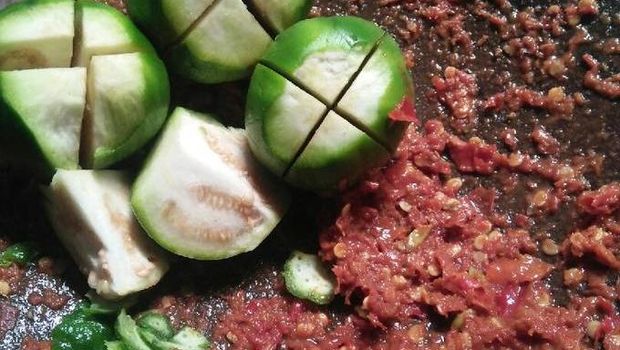 Lombok Terasi Sambal_Wahyuni Mardiana-Cookpad Lombok Terasi Sambal_Wahyuni Mardiana-Cookpad |
Lombok’s typical chili paste is unique in the use of local shrimp paste made from rebon shrimp, fish, or a mixture of both. This chili sauce has a dark color and distinctive aroma, suitable to be served with fresh vegetables, grilled fish, fried chicken and warm rice.
How to make:
1. Puree the chilies, shallots, garlic and Lombok shrimp paste.
2. Add a little sugar and salt, stir until evenly mixed.
3. The chili sauce is ready to be served.
Sirawir Sambal
This chili sauce comes from Tepal Village at the tip of Sumbawa Island. Having a complex taste with a combination of salty, sour and spicy, Sirawir sambal is often used as a mixture of soupy foods.
Ingredients:
• Salt
• Cayenne pepper
• Candlenut
• Kaffir lime leaves
• Laos
• Lemongrass
• Garlic
How to make:
1. Put all the ingredients into one container.
2. Grind all the ingredients until they have a rough texture and are evenly mixed.
3. The chili sauce is ready to be served.
This article was written by Firga Raditya Pamungkas, Independent Campus Certified Internship participant at detikcom
(nor/nor)


